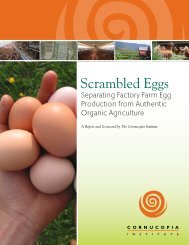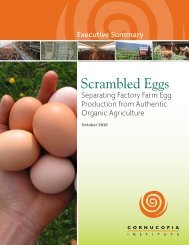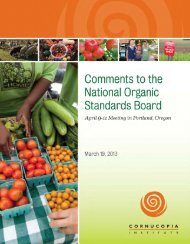“Behind the Bean” (pdf) - Cornucopia Institute
“Behind the Bean” (pdf) - Cornucopia Institute
“Behind the Bean” (pdf) - Cornucopia Institute
You also want an ePaper? Increase the reach of your titles
YUMPU automatically turns print PDFs into web optimized ePapers that Google loves.
ficient, requiring anywhere from 8 to 16 pounds of soybeans to produce 1 pound of beef, for example. 5 Soy foods such as tofu<br />
and soy “milk” (referred to hereafter as “soymilk”) allow people to source <strong>the</strong>ir dietary protein directly from a vegetarian<br />
food, without involving animals. As a result, foods such as tofu and soymilk are staples in <strong>the</strong> diets of most vegetarians.<br />
The organic soy scorecard rates soy foods companies.<br />
Those that nurture direct relationships with North<br />
American organic farmers received high scores.<br />
Photo source: istock.com<br />
The <strong>Cornucopia</strong> <strong>Institute</strong> asked companies that produce organic<br />
soy foods such as soymilk, tofu, and vegetarian burgers about <strong>the</strong>ir<br />
products, raw materials, and production practices. Part I of <strong>the</strong><br />
report examines, in depth, some of <strong>the</strong> criteria used for our scorecard.<br />
We were interested in each company’s commitment to organics<br />
and to avoiding contamination with genetically engineered<br />
organisms (GEOs). We were also interested in each company’s<br />
commitment to supporting domestic family farmers, which is why<br />
we asked about <strong>the</strong> sourcing of <strong>the</strong>ir soybeans. The majority of<br />
company participants source <strong>the</strong>ir soybeans directly from North<br />
American family farmers, and The <strong>Cornucopia</strong> <strong>Institute</strong> was able<br />
to verify <strong>the</strong>se claims. Companies that nurture direct relationships<br />
with North American organic farmers received high scores. All<br />
companies listed in <strong>the</strong> scorecard were given multiple opportunities<br />
to participate; while many chose to do so, some declined and<br />
were unwilling to share any information regarding <strong>the</strong> sourcing<br />
of <strong>the</strong>ir soybeans with <strong>Cornucopia</strong> researchers or, indirectly, with<br />
<strong>the</strong>ir customers.<br />
While Part I of <strong>the</strong> report focuses on <strong>the</strong> scorecard of organic soy companies, Part II examines <strong>the</strong> conventional (“natural”)<br />
soy industry. According to one survey, more than one-third (37%) of Americans specifically seek out soy foods for health<br />
reasons. 6 The FDA-approved health claim that “25 grams of soy protein per day may reduce <strong>the</strong> risk of heart disease” 7 certainly<br />
plays a role; <strong>the</strong> same survey found that 85% of respondents ei<strong>the</strong>r agreed with this claim or wanted more information.<br />
In this report, we will explore how this health claim came about as a result of pressure from corporations involved in soy<br />
processing—not health care professionals. This report will also briefly explore <strong>the</strong> debate surrounding natural substances<br />
found in soybeans—isoflavones—which are structurally similar to <strong>the</strong> hormone estrogen and exhibit weak estrogenlike effects<br />
in <strong>the</strong> human body.<br />
Any food to which scientists devote this much time and attention is bound to create controversy. Many see nothing wrong<br />
with eating minimally or traditionally processed soy foods in moderation, as one would eat any plant food in moderation as<br />
part of a balanced diet. However, given that highly processed soy protein ingredients are now found in more and more processed<br />
foods, as well as 25% of infant formula sold in <strong>the</strong> United States, it is worth noting some of <strong>the</strong> controversies around<br />
<strong>the</strong> purported health benefits of soy.<br />
Part II also exposes <strong>the</strong> natural soy industry’s “dirty little secret”: its widespread use of <strong>the</strong> chemical hexane. Hexane is used<br />
to process nearly all conventional soy protein ingredients and edible oils and is prohibited when processing organic foods.<br />
It is used in <strong>the</strong> food processing industry as a solvent to separate <strong>the</strong> oil from <strong>the</strong> protein and fiber of grains, including soybeans.<br />
It is a cost-effective solvent and highly efficient at creating high-protein isolates, but it is also a neurotoxic chemical<br />
that poses a serious occupational hazard to workers and is an environmental air pollutant. 8 Residue tests show that small<br />
amounts of hexane can and do appear in ingredients processed with this petrochemical. The government does not require<br />
that companies test for hexane residues before selling foods to consumers, including soy-based infant formula.<br />
Organic foods or foods labeled “made with organic ingredients” are almost always free of ingredients processed with hexane—<br />
but not always. Clif ® Bars, for example, misleads consumers with <strong>the</strong> “made with organic soy and oats” label, when one of<br />
<strong>the</strong> first ingredients listed is conventional, hexane-extracted “soy protein isolate.” And companies that use soy lecithin, a<br />
vital ingredient in foods such as chocolate and baby formula, have a choice between an organic, non-hexane-extracted version<br />
and a conventional version. Those that are truly committed to organic principles will choose <strong>the</strong> organic version—even<br />
with its higher cost—whereas companies that might be more concerned with <strong>the</strong>ir profits tend to choose <strong>the</strong> nonorganic<br />
version.<br />
8 Behind <strong>the</strong> bean: The Heroes and Charlatans of <strong>the</strong> Natural and Organic Soy Foods Industry.





